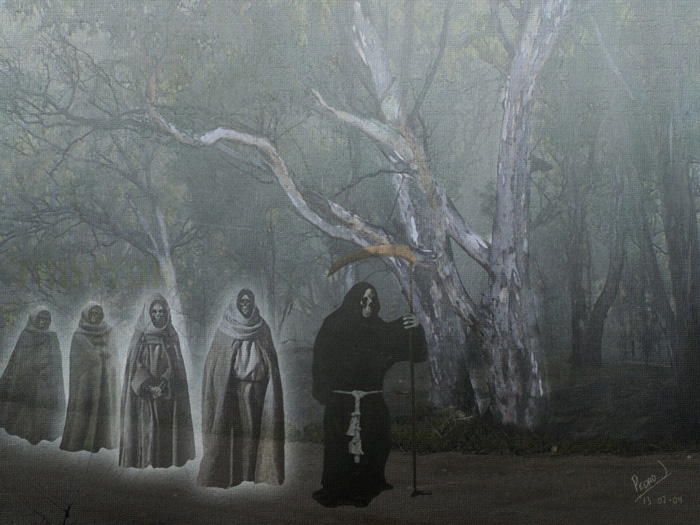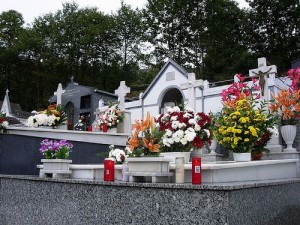Fiesta de Todos los Santos Posted by Magda on Oct 28, 2010 in Spanish Culture
Nos acercamos a una fecha en la que todo el mundo anglosajón se dedica a dejar vacías las tiendas de disfraces, y sin existencias de chucherías los supermercados. El 31 de octubre, Halloween o víspera de todos los santos, aquellos de vosotros que viváis en Inglaterra o Estados Unidos, quizá tengáis la suerte de cruzaros por la calle con E.T., Supermán, Frankenstein o mi adorado Drácula.
Sin embargo, la tradición religiosa en países latinos como España hace que esta noche tenga otro significado, aunque se mantengan también signos de otras tradiciones ancestrales. Es una noche para honrar a los difuntos, y rezar por las almas de aquellos que están en el purgatorio, para que sean así redimidos. Es propio encender una vela en cada casa en su honor días antes, y dejarla consumir, para que las almas encuentren su camino. Cuando la luz se apague, significará que un alma alcanzó la salvación. También hay creencia de que en esa noche, a los difuntos se les permite acercarse a este mundo, por lo que si hay algún pobre incauto que se atreva a salir a partir de las doce, bien puede encontrarse con la Procesión de las Ánimas en su camino.
En el día de Todos los Santos, 1 de noviembre, los cementerios se llenan de gente que pasa a visitar a sus familiares fallecidos, y dejarles flores como recuerdo. Esta tradición es compartida con países como México o Guatemala, donde la festividad es incluso más colorida, ya que elaboran dulces (calaveritas) y bebidas que llevan a los cementerios como ofrendas a sus difuntos. Para terminar, me quedo con un recuerdo de mi infancia: las visitas nocturnas al cementerio un grupo de chiquillos entre bromas y risas, antes de que fuese demasiado tarde para tropezar con esas temidas ánimas, y las historias de terror junto a la lumbre, mientras alguien tostaba castañas. Beber anís no, que ese era terreno de mayores. Y una vez en casa, terminar la noche leyendo a Bécquer, y su leyenda “El monte de las ánimas”, espeluznante… (pinchad en el título)
We are getting close to the date when the English-speaking world takes to raiding costumes stores, and making off with entire stocks of candies from grocery stores. On October 31st, Halloween, or Eve of All Saints, those of you who live in England or The United States, could be lucky enough to bump into E.T., Superman, Frankenstein or my beloved Dracula.
On the other hand, religious traditions in Latin countries such as Spain imbue that night with a different meaning, while also maintaining signs of other ancestral traditions. It is a night to honor the dead and praying for the redemption of souls that are trapped in purgatory. It is customary to light a candle at home in their memory days in advance, and let it consume, to help those souls find their way. When the light is extinguished, it means that one soul found salvation. It is also a belief that, on that night, the dead are allowed to get closer to our world so an unsuspecting pedestrian might come across the Parade of Souls right after midnight.
On the Day of All Saints, November 1st, graveyards will be filled with people who go to visit their dead relatives and bring them some flowers. This tradition is shared with countries such as Mexico and Guatemala, where the festivity is even more colourful, and includes the making of confectionery (calaveritas, or little skulls) and drinks that are then taken to the cemetery as an offering to the dead.
Before I leave, I’ll share one of my childhood memories: a group of joking and laughing kids visiting the cemetery at night, before it was late enough to meet the fearsome souls, and the tales of horror around a bonfire, while someone was roasting chestnuts. Drinking anisette was only allowed for grown-ups, though. Later at home, the night would be finished by reading Becquer and his legend “The Spirits’ Mountain”; terrifying… (click on the title for the Spanish version)

Build vocabulary, practice pronunciation, and more with Transparent Language Online. Available anytime, anywhere, on any device.






Comments:
Dirk Summers:
I can understand about 75% of this post. Right now I’m learning to speak Spanish through the Transparent Spanish software… well I guess so far so good…